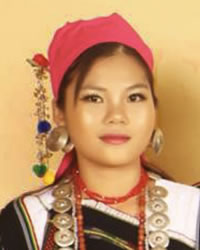Khongso in Myanmar (Burma)

Photo Source:
Copyrighted © 2026
Asia Harvest-Operation Myanmar All rights reserved. Used with permission |
Send Joshua Project a map of this people group.
|
| People Name: | Khongso |
| Country: | Myanmar (Burma) |
| 10/40 Window: | Yes |
| Population: | 3,000 |
| World Population: | 3,000 |
| Primary Language: | Chin, Anu-Khongso |
| Primary Religion: | Christianity |
| Christian Adherents: | 90.00 % |
| Evangelicals: | 38.00 % |
| Scripture: | New Testament |
| Ministry Resources: | Yes |
| Jesus Film: | No |
| Audio Recordings: | Yes |
| People Cluster: | Kuki-Chin-Mizo (Zo) |
| Affinity Bloc: | Tibetan-Himalayan Peoples |
| Progress Level: |
|
Identity
Although linguists have combined the Anu and Khongso tribes into one language group, because each community maintains a distinct culture and ethnic identity, they been profiled separately in this book. The Khongso are one of more than 60 different Chin tribes in Myanmar. The Khongso are not related to the similarly named Asang Khongsa tribe, which is located north and south of the Khongso territory, nor are they the same people as the Khongsai tribe of Manipur, India.
Location: Three thousand Khongso people inhabit 17 villages in the southern part of Myanmar's Chin State, primarily between the Kaladan and Michaung rivers in Paletwa and Sami townships within Matupi District. Paletwa is located just 11 miles (18 km) from Bangladesh and also shares a border with India. Most Khongso villages are situated northwest to west of Kyauk Pan Daung, a distinctive flat-topped mountain. The Khongso territory is fully surrounded by other Chin tribes, with the Likhy to the north and south; Khongtu and Lemi to the east; Anu, Khumi, Bawn, and Matu to the west; and several other groups located slightly further away.
Language: Khongso is closely related to Anu, but the two vernaculars are very different from other Chin languages. They belong to the Ngwi-Burmese branch of the Tibeto-Burman linguistic family, while almost all other Chin languages are part of the Kuki-Chin branch. Khongso, which has two dialects, reportedly shares only 23% to 37% lexical similarity with other Chin languages in the area.
History
The Khongso are thought to have migrated to their present area more than 200 years ago, where they faced many years of conflict with other groups before they were accepted and allowed to settle down on their own land. The 1931 census of Burma conducted by the British listed 1,151 “Kaungtso” (Khongso) people. All were identified as animists with no Christians among them at the time. The civil war currently engulfing Myanmar has affected the Khongso area, with men being forcibly conscripted to fight in the brutal conflict as Paletwa changed hands. In January 2024 the Arakan Army—one of many waging war against the Burmese junta—seized control of Paletwa and closed the nearby border. Work on India's Kaladan Transportation Project, planned to improve connections between India and Southeast Asia, came to a halt because of the turmoil, which resulted in 50,000 Paletwa residents (approximately half the population) being displaced.
Customs
Most Khongso people lead simple lives as they try to eke out a living from the land. Because their area is sub-tropical, an abundance of fruit trees grow there, including bananas, oranges, and mangoes. Any excess fruit is sold to other tribes along the river systems, but due to the extreme hardships of recent years, Khongso communities have needed to keep all the food they grow. Khongso women typically wear attractive black, green and red skirts, and they wrap pink scarves around their heads.
Religion
Almost all Khongso people are Christians today, with only a small number adhering to the animistic beliefs of their forefathers. Some families have also converted to Buddhism after being enticed by government benefits that are unavailable to followers of Jesus Christ in Myanmar. Churches are found in every Khongso village today, with many believers experiencing a vibrant faith in recent years after the publication of the New Testament in their language in 2022.
Christianity
At least seven Christian denominations (Evangelical Free Church of Myanmar, Anglican, Word of Life, Myanmar Baptist Christian Mission, Believer Church of Jesus Christ, Roman Catholic Mission, and Lutheran) are working among the Khongso people. A breakthrough for the Khongso church occurred when the New Testament was completed in 2022. Previously, many Khongso believers struggled to gain a firm foundation in the faith because the Scriptures were not available in their heart language.